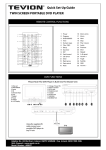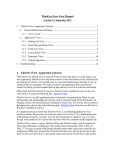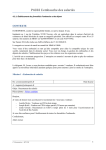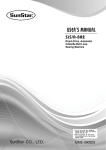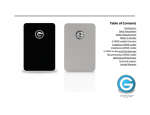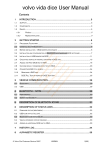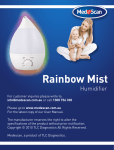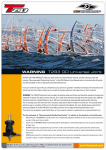Download mode d`emploi mise en page 7
Transcript
Owner's Manual TIWAL 3.2 TIWAL SAS Le Prisme – CP 111 – Place Albert Einstein Parc d'Innovation Bretagne Sud 56038 VANNES cedex – France www.tiwal.com SAS with a share capital of 45 000 Euros - R.C.S. Vannes 753 131 713 - Siret 753 131 713 00012 - APE 4764Z INTRODUCTION You are the owner of a TIWAL 3.2 dinghy made by TIWAL. This manual will advise you how to find both enjoyment and safety in navigation. Inside you will find technical specifications, assembly instructions, maneuvers and recommendations for maintenance. If the TIWAL 3.2 is your first dinghy or one that you aren't accustomed to, we recommend that, at first, you familiarize yourself with it's operation in calm weather conditions. Get in touch with your local sailing clubs or schools for advice regarding possible instruction. READ THE MANUAL IN DETAIL BEFORE USING THE TIWAL 3.2 TO FAMILIARISE YOURSELF WITH IT'S OPERATION AND HANDLING. Make sure that prevailing wind and sea conditions are suitable for the boat's design category, and that you and your crew are able to navigate the boat in these conditions. This owner's manual is not a detailed guide for maintenance and repair. If you are experiencing difficulties, please get in touch with the manufacturer or a representative. Always seek out the services of an experienced professional for maintenance and whenever fitting accessories or making modifications. All modifications that could impact the safety characteristics must be evaluated, executed and documented by competent professionals. TIWAL SAS cannot be held liable for modifications that are not approved by the manufacturer. Certain countries require a permit or authorization for navigation or require that specific rules be followed. Always perform the suggested maintenance on your boat and take into account that wear and tear will result over time or, as the case may be, from frequent or inappropriate use. Any boat (however sturdy) can be severely damaged if it is subject to inappropriate use. This is incompatible with safety in navigation. Always adjust the boat's speed and direction to prevailing conditions. On board, the crew must have access to certain safety equipment (life-vests, etc.) that is suited to the type of boat, the weather conditions, etc. Such safety equipment is legally required in certain countries. The crew must be familiar with the use of this equipment and with emergency safety maneuvers (man overboard, towing, etc.); regular training sessions are available through local sailing clubs and schools. PLEASE KEEP THIS MANUAL AND GIVE IT TO THE NEW OWNER WHEN YOU CHOOSE TO SELL THE BOAT Technical specifications - Boat type : dinghy - Design category : D - Length of the hull : 3.20 m - Width of the hull : 1.30 m - Width of the hull with side wings : 1.60 m - Hull weight : 25 kg - Total weight : 50 kg - Maximum engine power : 0 cv - Maximum number of passengers : 2 adults or 1 adult and 2 children - Maximum load passengers + baggage : 180 kg - Maximum load on the wings : 90 kg - Sail surface area : 5.20 m² / 7m² - Manufacturer : TIWAL FIRST TIME Daggerboard bungee Ratchet block Make sure the daggerboard bungee is loose enough for easy adjustment, but tight enough to hold the daggerboard up at any height while sailing or in the event of capsizing. FIRST TIME Prior to first use, recharge the low pressure electric pump with AC adapter (220V) for at least 10 hours or 1 hour with DC power source 12V. Attach the larger nozzle to the pump. Yellow line Red line Red line Hiking Strap Bungee ASSEMBLY Roll out the hull on a surface free from debris that could cause any damage. Open the valve. Before inflating with the low pressure electric pump, push down and turn the yellow spring loaded button. Make sure the yellow spring loaded button is in the DOWN position. Inflate the hull with the electric pump until it starts taking shape without being pressurized. Pression <0,1 psi. 2 Then quick push down and turn the yellow spring loaded button. Make sure the yellow spring loaded button is in the UP position. The valve is closed. 1 3 4 If sand is left inside the sleeves or on the rods, assembly could be made difficult if not impossible. ASSEMBLY 6 5 8 7 Check that all the push-pins are correctly locked into their corresponding sockets otherwise the structure can fall apart. ASSEMBLY 9 Double Yellow line Do not let any sand on the velcro strap. Check that the transom is centered with the yellow band. To inflate with the manual pump, keep the yellow spring loaded button is in the UP position. Your pressure gauge may not read any pressure until you reach 0,7 psi. Pression MAX 11 psi 10 Check that the valves located at the back of the hull are closed before sailing. ASSEMBLY 7m2 sail Slide the battens into the batten pockets. Then secure the battens with the strap. 11 7m2 sail mast extension 12 13 Wind (Beaufort) 1 2 3 4 5 5.2 m2 sail ok ok ok ok Forbidden 7m2 sail ok ok ok Forbidden Forbidden ASSEMBLY Once the mast is inserted into the luff tube of the sail, tighten the boom pocket with the velcro strap. Adjust the tension with the velcro strap so the boom is tightly hold in the boom pocket. 15 14 ASSEMBLY 16 17 18 Before going sailing, make sure the safety-pin is inserted in the hole of the rudder pintle (upper) and this prevents the rudder from coming out. ASSEMBLY 19 20 ASSEMBLY 22 21 DISASSEMBLY To disassemble the boat just follow the assembly steps in reverse order. In order to disassemble the structure, press on the 4 push-pins of the seat spar and rotate it, then slide it forward. Fold the luff part of the sail over on itself. The crease should only be on the black fabric. (For the 7m2 sail only, remember to take out the battens.) Assembly and disassembly Always assemble and disassemble the boat (including the sail and the mast) on the ground in order to avoid loosing pieces in the water. Sails and wind range The 5.20 m2 sail is a multipurpose sail. It works well for variable wind conditions: F2 -‐ F4 Beaufort (4 to 16 knots – 5 to 28 km/h). The 7.00 m2 sail is a powerful sail for light-‐wind condition only : F2 -‐ F3 Beaufort (4 to 10 knots – 5 to 19 km/h). NOT FOLLOWING THE ABOVE INSTRUCTIONS CAN RESULT IN DAMAGE TO THE ALUMINIUM STRUCTURE (5.20M2 AND 7 M2 SAIL) AND / OR TO THE MAST EXTENSION (7.00 M2 SAIL) Boat launch Once the boat is prepared for navigation, two people, each holding a wing, are required to carry it to the water. Or use a launching trolley approved by the manufacturer. Always carry the boat, do not drag it along the ground. On the water Make sure that the tiller and tiller extension are clear of any clutter (bridle, sheet end,...). Lower the rudder and insert the daggerboard once there is enough depth. Capsizing risks: the dinghy is likely to capsize in high winds or when the passenger weight is unevenly distributed. Even when used with skill and care, the boat is designed in such a way that capsizing is always a possibility, even in calm navigation conditions. Righting the boat, in the event of capsizing -‐ Make sure that the sheets are eased and the daggerboard is out. -‐ Stand on the wing and use your body as a counterweight by holding onto the daggerboard with your crew's help, only if necessary. -‐ Once the mast is lying horizontally on the water, face the boat into the wind holding it from the front. -‐ Get your crew member to down on the daggerboard (as though to climb on) until the boat is fully righted. Warning: do not keep your head under the hull or the wings when the boat is righted. -‐ Keep facing the boat into the wind until someone is on board and in control of the boat. -‐ Climb on from the front. WARNING : NEVER LET GO OF THE BOAT. If you fall in the water, keep a hold of the boat even if it has capsized. A sailboat drifts faster than someone swimming. The minimum passenger's weight on board must be 60kg for one passenger or 80kg for two passengers to right the boat in the event of capsizing. Towing -‐ Remove the daggerboard when towing the boat. Returning When returning to shore, raise the daggerboard, then the rudder. Always hand-‐carry the boat to the shore or use a launching trolley. Transportation ALWAYS CARRY THE HULL IN THE BAG : THE SIDES OF THE BOAT ARE VERY FRAGILE WHEN THE HULL IS DEFLATED. THE HULL COULD BE DAMAGED IF IT COMES INTO CONTACT WITH AN OBJECT. When the boat is transported on a car roof, check that the load does not exceed the maximum capacity allowed for the roof or gallery. Always tie down the bags. The boat shall not be transported on a car roof when it is assembled. Maintenance Please read the following tips and advice to keep your boat in perfect working order: DO NOT STORE YOUR BOAT UNDER DIRECT SUNLIGHT. THE MOST COMMON REASON FOR PREMATURE INFLATABLE BOAT AGING IS EXPOSURE TO THE SUN AND ITS DAMAGING UV RAYS. IF YOU LEAVE YOUR BOAT EXPOSED TO THE HOT SUN, CHECK THE PRESSURE AND DEFLATE IT SLIGHTLY. OTHERWISE, THE HULL MAY BECOME OVER INFLATED AND STRETCH THE MATERIAL. Do not leave your boat outside for more than a few days without putting a boat cover or piece of tarp over it. After using your boat at sea, always use fresh water to rinse the hull, the fittings and the equipment. Do not forget to rinse thouroughly the hole in the hull where the daggerboard passes through. Sand and gravel inside the daggerboard hole can cause abrasion that eats away the fabric. Never use strong detergents or silicone-‐based products to clean your boat or any other household cleaners. Only use water. Always close the valves before rinsing the boat or transporting it. For long term or winter storage, take care to dry the hull as well as the sails and other accessories After each use, fold or roll up the sail in order to store it away as neatly as possible; this will reduce wear and tear. Only wash the sails with cold or tepid water and possibly a very mild soap; never use detergents. Have the sails inspected once a year by a specialist. Perform periodic inspections of the fittings to avoid problems caused by normal wear and tear during navigation. Fix small problems when they come to your attention, so they don't get worse over time. If you decide to store your boat assembled for a long period of time, deflate it partially and cover with a tarp. Inspect every part of the standing and running rigging regularly in order to detect signs of damage or wear and tear. The 2 year limited warranty does not apply to damage resulting from accident, misuse, abuse, lack of reasonable care, failure to follow safety and instructions. WARNINGS & RECOMMENDATIONS : USE OF THIS PRODUCT AND ANY OF ITS COMPONENTS INVOLVES CERTAIN INHERENT RISKS, DANGERS AND HAZARDS, WHICH CAN RESULT IN SERIOUS PERSONAL INJURY AND DEATH. IN USING THIS PRODUCT YOU FREELY AGREE TO ASSUME AND ACCEPT ANY AND ALL KNOWN AND UNKNOWN RISKS OF INJURY WHILE USING THIS EQUIPMENT. THE RISKS INHERENT IN THE SPORT CAN BE GREATLY REDUCED BY ABIDING TO THE WARNING AND SAFETY PRECAUTIONS LISTED IN THIS USER GUIDE AND USING COMMON SENSE. Sailing is a dangerous sport. Use of this product exposes the user to unexpected risks, dangers and hazards. Always use extreme caution when using this product. Never act in a careless manner when using this product. Misuse of this product may result in serious injury or death. Only use this product if you are in good physical health, and know how to swim. You are responsible for your own safety and the safety of others around you when using this product. If you are under the age of 18, you must have a legal guardian read these warnings and safety precautions. Do not use this product without adult supervision. Do not seat more than one person (max weight 90kg) on the seat spars. Do not stand up on the wings or the seat spars. The mast is a conductor of electricity. A fatal accident could occur should the mast come into contact with power lines. Exercise extreme caution during navigation and most particularly while installing the mast and carrying the boat in and out of the water. Know your limitations and sail within your own ability and that of your crew. Always check marine weather forecasts before setting out. Check how many passengers are authorized on your boat (Builder's plate next to the rudder). Tell someone on shore of your plans to take the boat out on the water. It is the boat owner's responsibility to ensure that the vessel is fitted with all the safety equipment required and that this equipment is stored in a way to make it easily accessible while navigating or in the case of an emergency. Safety regulations vary depending on the country where the boat is registered. Do not navigate in shallow rocky areas likely to damage the hull. Watch out for ebbing winds and currents. NEVER take the boat out if you have been drinking or taking drugs. Everyone on board must at all times wear a suitable CE approved safety vest. Protect yourself with suitable clothing. Wear a dry suit or a wetsuit in cold water or when it's cold out. Take protective measures against sun and heat. Keep well hydrated. Learn the right of way rules at sea and when in doubt give way to others. When you aren't navigating, always face the boat into the wind whether on water or on land. Only use the sails approved by the manufacturer. Read the user's manual of the manual and electric pumps. Do not use a motor on the dinghy. Only use original replacement parts. Make sure the boat is pressurized correctly. Do not use an air compressor. It will result in damage to the hull, and will void all warranties. Follow the instructions provided on the manufacturer's safety plate. Do not exceed the maximum authorized load. The user of this boat understands and recognizes the safety risks inherent to sailing. Read this manual carefully. Make sure that everyone has read and understood these safety measures. To sail not further than 2 miles to sea, the following security and safety items are required in most European countries : -‐ Buoyancy aid for each person on board (with minimum 50N, and CE marked) -‐ Personal light / torch REGISTRATION We bring to your attention that most pleasure boats should be registered. To proceed to this registration, we invite you to contact the local maritime authorities in your country. Your TIWAL 3.2 declaration of conformity will be required to this end. If you did not receive it, please contact your reseller.



















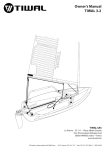
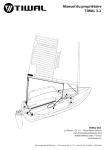
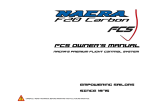


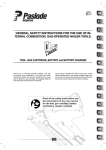
![2010 [FACILITATOR]](http://vs1.manualzilla.com/store/data/005655528_1-cab0d059d42c2f5dfa4b2de0f050c49f-150x150.png)


